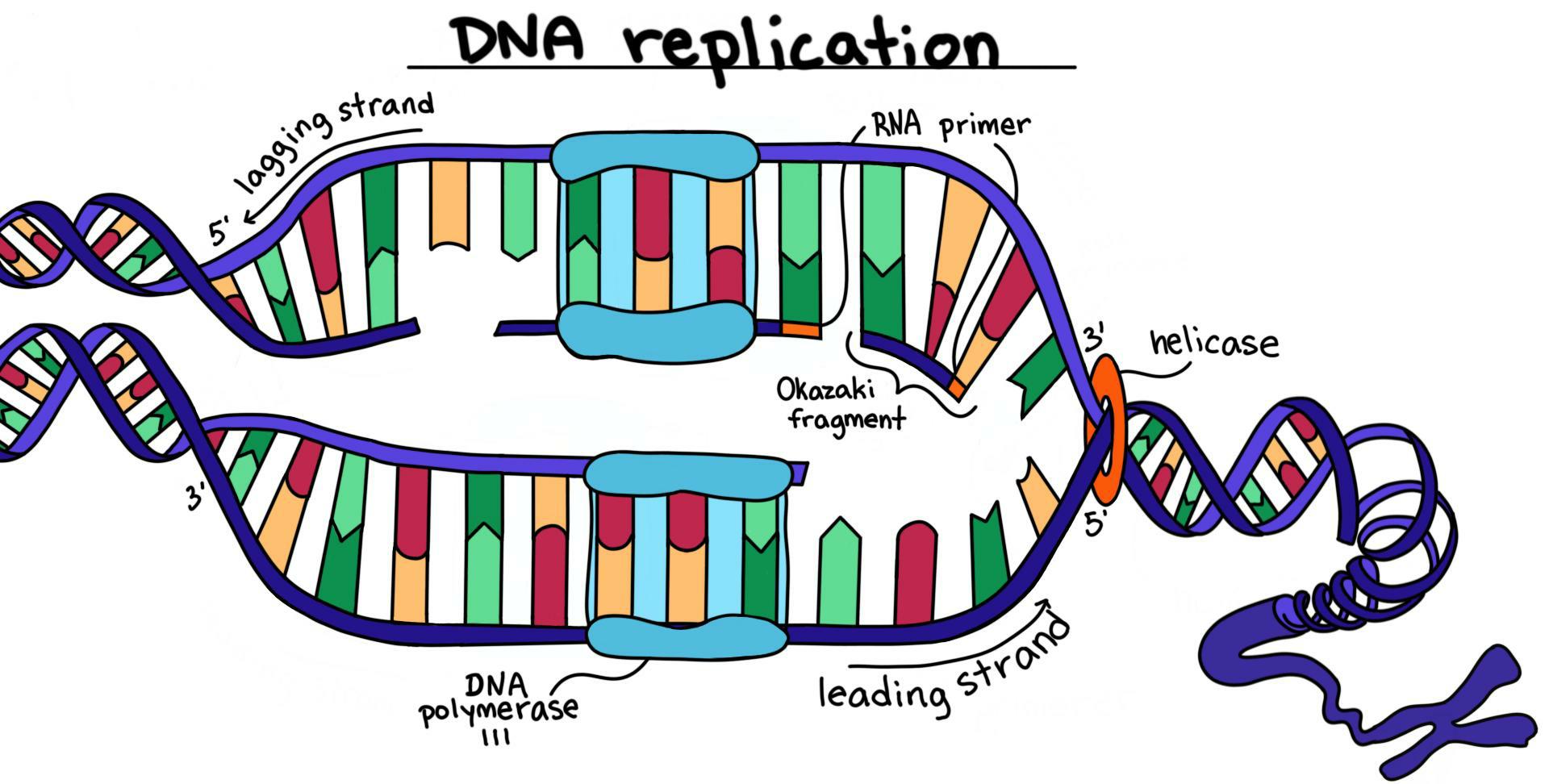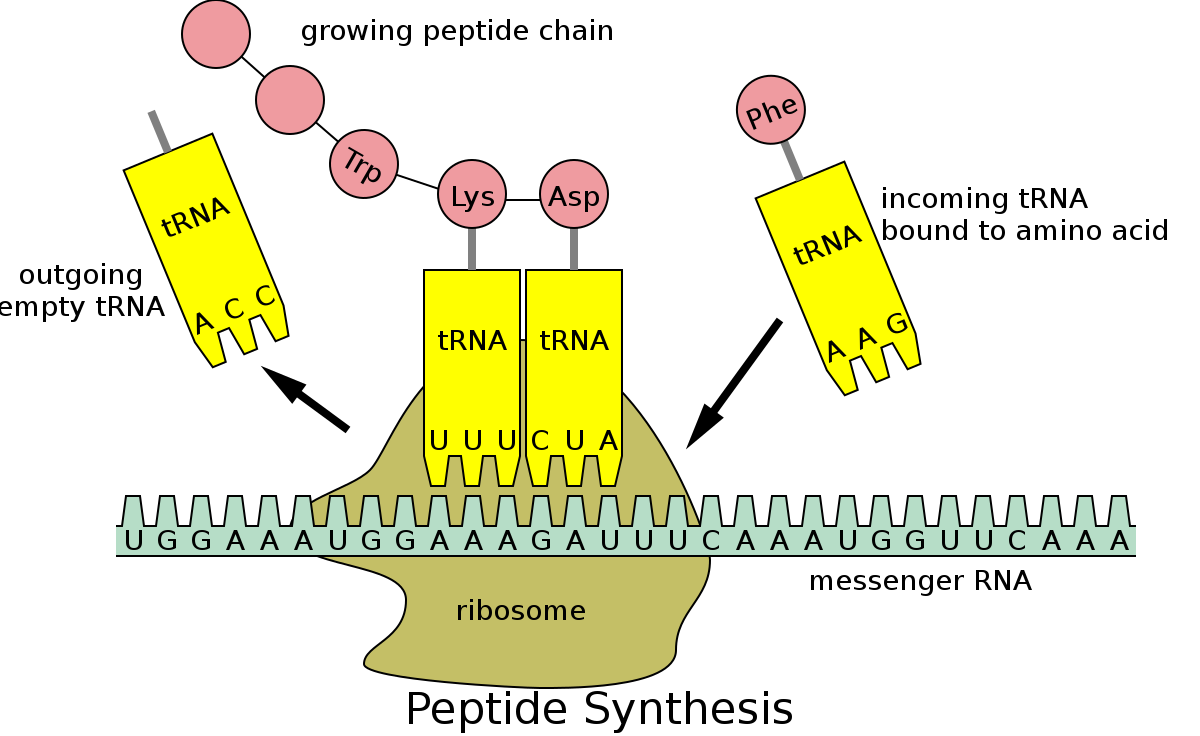DNA and RNA: The genetic material of a cell
The cell's genetic material is stored in DNA (deoxyribonucleic acid). The central dogma of life states that information flows from DNA to RNA to proteins. Proteins are the main way in which traits are exhibited by the organism. Both DNA and RNA are composed of nucleotides, which are A, T, C, and G for DNA and A, U, C, and G for RNA. Nucleotides consist of a nitrogenous base, five carbon sugar, and a phosphate group.
DNA Replication
Cell division was described in detail in my Cell Division blog, but the replication of DNA was not examined at the molecular level.
In DNA replication, the double-stranded DNA molecule is unzipped by helicase, an enzyme. Each of the two strands is a template that is used to create a new complementary strand is a process called semiconservative replication. The reason DNA replication is called semiconservative is because the original strand of DNA is part of the new replicated DNA.
Steps of DNA replication:
- Helicase unwinds the DNA and produces a replication fork. To prevent the two complementary strands of DNA from joining back together, single stranded binding proteins (SSBs) binds to the DNA. Topoisomerase is an enzyme that untwists the DNA to relieve pressure during DNA replication.
- Primase begins DNA replication. It determines where to start replication by binding an RNA primer to a specific nucleotide sequence, which is called an origin of replication.
- DNA polymerase binds to the RNA primer and starts a process called elongation, which is when DNA nucleotides are added to the newly built DNA strand.
- The leading complementary strand is created continuously with no breaks, while the lagging complementary strand is assembled by joining together short Okazaki fragments with the help of DNA ligase.

DNA Repair
During DNA replication, some mistakes may occur. Although these mistakes are usually rare, they can be disastrous if left unchecked. For this reason, there are many proteins that check DNA for mistakes and take steps to fix the mistakes:
DNA polymerase proofreads the added nucleotides and ensures that they match correctly to the corresponding nucleotide base on the template strand. In case DNA polymerase misses something, mismatch repair proteins fix the remaining errors. In the case that nucleotides are damaged by environmental factors such as UV light or toxins, excision repair proteins identify the damaged nucleotides and remove them. Polymerase then adds new undamaged DNA to replace the missing nucleotides.
How Proteins are Synthesized
Proteins are essential for the cell to function correctly. The cell must use the instructions encoded in the DNA to create an RNA, which is translated into a protein. Protein synthesis consists of three main steps: transcription, RNA processing, and translation. During transcription, DNA is read and RNA is synthesized. Once the RNA is created, RNA processing occurs. The RNA strand is modified with insertions and deletions. The mature RNA strand is then used as a template to create a protein. Let's take a look into the first stage of protein synthesis - transcription!
Transcription
Transcription is divided into 3 phases: initiation, elongation, and termination.
During initiation, the RNA polymerase binds to a promoter region on the DNA strand and begins adding nucleotides to a new RNA strand.
Elongation refers to the lengthening of the new RNA strand when RNA polymerase adds nucleotides to the new strand. The new strand is synthesized in the 5' to 3' direction and the nucleotides A, U, C, and G are used.
Termination is when the RNA polymerase recognizes a sequence of nucleotides that encode a stop point. The new RNA strand is completed.
mRNA processing
The mRNA is altered before leaving the nucleus. A 5' cap of guanine nucleotides and a poly-A tail is added to the mRNA strand. RNA splicing also occurs, which is when introns are spliced out and the remaining exons are put together. The cutting out is done by small nuclear ribonucleoproteins (snRNPs), which consist of small nuclear RNAs (snRNAs). Millions of different mRNAs can be made from a single mRNA strand depending on the locations of the introns and exons. These different RNAs can be created by the process of alternative splicing.

Translation
Once the mRNA has finished processing and it leaves the nucleus, it goes into the cytoplasm. tRNAs (transfer RNAs) contain a codon (group of 3 RNA nucleotides) and the corresponding amino acid. When the mRNA is being read by a ribosome, the tRNAs create a protein by continuously adding amino acids, as shown in the figure below.

